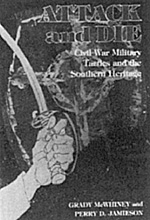
by Grady McWhiney and Perry D. Jamieson
University of Alabama Press
This is a very good book for anyone interested in the tactics used during the American Civil War. The authors show that throughout the war losses were considerably greater for the attacker than the defender, yet, with a shortage of manpower and supplies the Confederacy continually resorted to the attack trusting that courage and elan would carry the day. That the leaders of both sides were proponents of the attack, was, in the authors' opinion, due to three factors: the military background of the generals, the tactical teachings of the period, and the Celtic traditions of the Southern states.
The first section in the book, deals with the numbers of men lost by various generals in major battles throughout the war. This information is presented along with a number of tables covering who the attacker was during the battle, the winner, the number of casualties suffered by both sides and the percentage of the forces engaged lost during the battle. An interesting set of tables show the numbers of men and the percentage of men lost by the Southern generals at various battles compared to the losses of the Union commanders that they faced. As shown here, Lee lost twice the number of men as McClellan during the Seven Days Battles.
The remainder of the book deals primarily with the tactics of the period. The point is made that many of the general officers on both sides during the Civil War had served in the Mexican War using massed musket fire and bayonet charges to carry a position. That they continued to employ these once successful methods in the face of rifles and rifled artillery is not entirely surprising. The officers who had not served in the Mexican War learned from the books on tactics written by those who had. These books were originally written when the musket was the primary arm of the infantry and only a few select units were armed with r1if les. Revisions though made, did not allow for the greater range and accuracy of the new weapons with the exception of allowing a faster marching pace to deploy the men more rapidly. This section also deals with the - uses of infantry, cavalry, artillery, bayonet attacks and entrenchments ' Both the theoretical ideals and the actual employment of the tactics are covered in these chapters.
The final chapter attempts to explain the Southern tactics in terms of their heritage from the Celtic tribes of Scotland, Ireland and Wales. The romantic idealism, the wild yelling charge and the tendency to view each battle as a separate entity to be won with no regard for the future the authors feel typify Celtic warfare from the time of the Romans through the American Civil War.
Whether one agrees with the authors' views or not, this book presents an excellent analysis of the tactics used during the Civil War and the reasons behind their use. I would recommend this book to anyone interested in the Civil War without reservation.
More Reviews
-
Ral Partha 25mm British Colonials (figures)
Stone Mountain 20mm ACW (figures)
Platoon 20 25mm modern (figures)
Fusilier Miniatures 30mm Napoleonic (figures)
Painting Services: Terry Sirk and Alatair Ltd.
Freicorps 15mm 7YW (figures)
Miniature Marvels 1mm 17th C. Pike and Shot (figures)
Minifig Napoleonics and Ancients (figures)
Attack and Die: ACW Tactics (book)
Armies of the Middle Ages (book)
Paper Soldiers: Crusaders and Their Foe
The Complete Brigadier 1680-1880 (rules)
Back to Table of Contents -- Courier Vol. IV #4
To Courier List of Issues
To MagWeb Master Magazine List
© Copyright 1983 by The Courier Publishing Company.
This article appears in MagWeb (Magazine Web) on the Internet World Wide Web.
Other military history articles and gaming articles are available at http://www.magweb.com